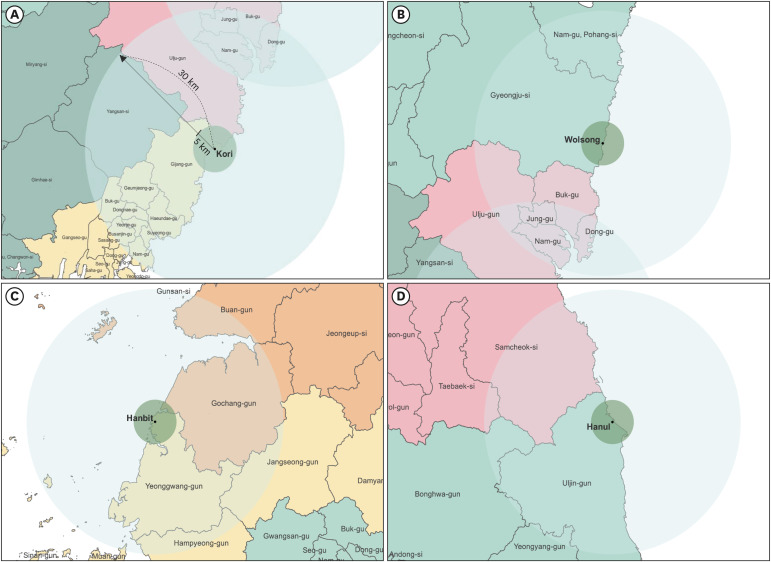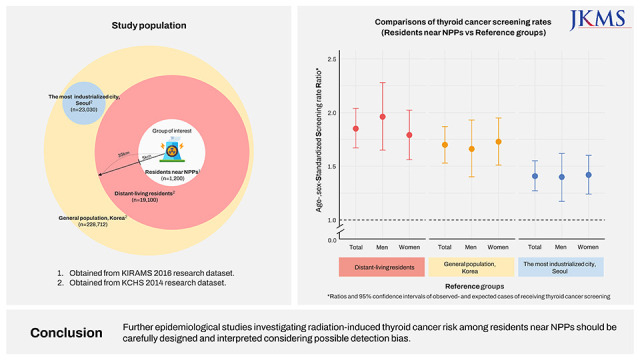The issue of health risks, including thyroid cancer, among the residents living around nuclear power plants (NPPs) has continued in Korea; the recent detection of tritium at one of the NPP sites has prompted an investigation on the health assessment of residents living near NPP sites.
1 In previous studies, elevated risks of thyroid cancer in NPP areas have been reported.
234 However, interpretation of these results has been controversial,
56 and frequent screening for thyroid cancer has been suggested as a probable explanation.
347 Since a national cancer screening program provided free examinations in Korea, thyroid cancer screening has been widely offered as a cheap add-on. Consequently, the number of individuals screened for thyroid cancer soared, and the issue of overdiagnosis of thyroid cancer followed.
89 However, the overall increase in thyroid cancer screening across the country cannot fully explain the relative differences in the risk of thyroid cancer by region, specifically, the higher risk in NPP neighboring areas, without relevant information on thyroid screening. Therefore, this study aimed to compare thyroid cancer screening rates of residents living near NPPs with those of distant-living residents and the general population.
This study utilized two research datasets obtained from face-to-face surveys. The first dataset was obtained from a study regarding the radiation risk perception of residents living in NPP neighboring areas conducted by the Korea Institute of Radiological and Medical Sciences (KIRAMS) in 2016. Detailed information on the study design and population has been previously reported.
10 Briefly, data were collected from 1,200 residents, aged 20–84 years, in NPP neighboring areas, which refers to the precautionary action zone within a 3–5 km radius of the four NPPs (Kori, Hanbit, Wolsong, and Hanul). The questionnaires consisted of radiation risk perception-related subjects and characteristics, including demographics and medical examination experience. We designated these 1,200 residents as the group of interest to examine thyroid cancer screening rates among residents living near NPPs. The second research dataset, which was used to select the reference groups for the comparison of thyroid screening rates, was obtained from the 2014 Korean Community Health Survey (KCHS), a nationwide survey of health interviews conducted by the Korea Disease Control and Prevention Agency (KDCA).
11 Annually, an average of 900 individuals aged ≥ 19 years participate in the survey at each health center in 254 local districts, yielding approximately 230,000 participants. In the KCHS, we operationally defined two reference groups as distant-living residents (n = 19,100), referring to individuals living in the 21 administrative districts (‘Si,’ ‘Gun,’ or ‘Gu’ units), mostly or fully located within a 30 km radius of the respective NPP sites (
Fig. 1), and the Korean general population (n = 228,712), respectively. The reference groups and the group of interest (i.e., residents living near NPPs) were not mutually exclusive because the regions of the reference groups included the regions of the group of interest. Information on thyroid cancer screening was assessed using the following question, which was identical in both surveys used for this study: “Have you ever received cancer screenings, for checking health status, not for any specific symptoms in the last two years?” Subsequently, screening for specific cancer types, such as the stomach, liver, colon, thyroid, prostate, breast, and cervix, were queried of those with cancer screening experience.
Fig. 1
Geographic zones indicating the areas of interest, within 5 km from NPPs, and one of the reference areas, within 30 km from the NPPs, by the NPP sites. Reference areas of distant-living residents included the following 21 administrative districts: (A) Parts of Busan metropolitan city (Geumjung-gu, Gijang-gun, Nam-gu, Dongnae-gu, Buk-gu, Suyeong-gu, Yeonje-gu, Haeundae-gu, Busanjin-gu), Yangsan-si, and part of Ulsan metropolitan city (Ulju-gun). (B) Parts of Ulsan metropolitan city (Jung-gu, Nam-gu, Dong-gu, Buk-gu), Nam-gu (Pohang-si), and Gyeongju-si. (C) Gochang-gun and Yeonggwang-gun. (D) Uljin-gun and Samcheock-si.
NPP = nuclear power plant.


Demographic characteristics are presented as mean ± standard deviation or frequency (%), as appropriate. We compared the thyroid cancer screening rates of residents living near NPPs with those of distant-living residents or the general population by calculating standardized screening rate ratios (SSRs) with 95% confidence intervals (95% CIs). Age- (10-year intervals) and sex-specific SSRs were computed as the ratios of the number of observed cases in residents living near NPPs divided by the number of expected cases based on the screening rates of distant-living residents or the Korean general population. Sensitivity analyses were conducted to confirm the robustness of our findings. First, in the group of interest, we excluded residents who were current (n = 33) or past (n = 49) radiation workers. Second, another reference region was defined as the most industrialized city in Korea (i.e., Seoul). All statistical analyses were performed using SAS version 9.4 (SAS Institute Inc., Cary, NC, USA).
Supplementary Table 1 shows the demographic characteristics of the study population. Residents living near NPPs had a higher proportion of men, and their socioeconomic status was not significantly different from distant-living residents or the general population. The age distributions were also similar.
Table 1 presents the age- and sex-SSRs for thyroid cancer between residents living near NPPs and distant-living residents or the general population. Noticeably, compared to distant-living residents or the general population, residents living near NPPs had 1.85 (95% CI, 1.67–2.04) and 1.70 (95% CI, 1.53–1.87) fold higher thyroid cancer screening rates, respectively. Furthermore, in sex-stratified analyses, the size and direction of the results were aligned with the main findings.
Table 1
Age- and sex-standardized thyroid SSRs among residents living near nuclear power plants compared to the reference groups (distant-living or general population)

|
Groups |
Living near NPPs |
Reference groups |
|
Distant-living |
General population |
|
Total |
Obs. |
Exp. |
SSR |
95% CI |
Exp. |
SSR |
95% CI |
|
Total |
1,200 |
384 |
207.1 |
1.85 |
1.67–2.04 |
225.4 |
1.70 |
1.53–1.87 |
|
Men |
621 |
151 |
76.9 |
1.96 |
1.65–2.28 |
90.7 |
1.66 |
1.40–1.93 |
|
Women |
579 |
233 |
130.1 |
1.79 |
1.56–2.02 |
134.7 |
1.73 |
1.51–1.95 |

In this study, residents near NPPs demonstrated significantly higher screening rates for thyroid cancer than distant-living residents or the general population. People in rural areas are more likely to have low access to healthcare services.
1213 Notwithstanding, residents living near NPPs, usually in remote areas, showed significantly higher screening rates for thyroid cancer than distant-living residents or even citizens of Seoul (
Supplementary Table 2). Conceivably, yearly assistance programs for residents living in NPP neighboring areas (e.g., medical check-ups) by NPP operators or local governments
14 might have affected screening rates. Furthermore, we may infer the impact of the assistance program from the current study findings that the regional screening rates differed according to cancer type depending on the inclusion of the national cancer screening programs. For example, in cancers such as stomach, colon, breast, and cervix, included in the national cancer screening programs, residents near NPPs and the general population presented similar screening rates, while the rates differed in other specific cancers such as thyroid, liver, and prostate (
Supplementary Table 3). In Korea, every one or two years, the government provides national cancer screening programs for early detection of five major types of cancer, including stomach, colon, liver (high-risk group only), breast, and cervix, so the whole nation benefits from cancer prevention.
15 As regular check-ups are provided nationally, the screening rates for these cancers (except for liver cancer with limited eligibility for screening in the national cancer screening programs) would not have been prominently different by region. However, medical check-up assistance programs for residents in NPP neighboring areas usually consist of more comprehensive examinations than the national cancer screening program. Thus, higher screening rates for specific cancers among these residents might have been attributable to assistance programs.
However, several limitations should be addressed when interpreting the study results. One was the time difference between the two studies used. We could not compare studies conducted in the same year due to the unavailability of information on thyroid cancer screening in the KCHS survey questionnaire since 2015; information on thyroid cancer screening was no longer available. However, the time difference is unlikely to have altered our main findings considering a trend toward decreasing thyroid cancer during 2014–2016 (data available on the Korean Statistical Information Service Website at
http://kosis.kr), the time window regarding the screening experience of our interest group, with a committee recommendation against frequent screening for thyroid cancer (e.g., over diagnosis of thyroid cancer) in adults without symptoms.
1617 While the overall trend of thyroid cancer screenings had diminished over time, screening rates for residents living near NPPs, which were obtained two years after those for the general population, were still significantly higher than those for the general population. Another limitation is that the study population may include current or past radiation workers, which may influence screening rates. It has been previously reported that radiation workers are more likely to receive screening tests for thyroid cancer than the general population, which may be explained by an annual medical check-up with cheap add-on tests for radiation workers.
18 Information on radiological work experience was available only for the group of interest (i.e., residents living near NPPs) and not for the reference groups. Therefore, as sensitivity analyses to minimize the possible influence on higher screening rates in the group of interest due to the inclusion of radiation workers, we excluded individuals who were current/past radiation workers. Accordingly, the estimates of the main results slightly diminished, but with statistical significance (
Supplementary Table 2).
To the best of our knowledge, this is the first study to compare thyroid cancer screening rates between residents near NPPs and the general population using direct measures through surveys for thyroid cancer screening experience, rather than a surrogate marker such as medical utilization. Presumably, the current study findings may indicate that detection bias due to increased thyroid screening cannot be negligible in studies on thyroid cancer risk among residents near NPPs; the higher screening rates for thyroid cancer among the residents might have led to a higher probability of thyroid cancer detection. Thus, inappropriate study designs, without accounting for screening experience, may lead to a spurious association between residents near NPPs and thyroid cancer, especially causing an overestimation of the positive association. In conclusion, our findings support that information on thyroid cancer screening needs to be considered in further epidemiological studies, particularly in countries with healthcare assistant programs for residents near NPPs, to examine the true association between residing near NPPs and thyroid cancer.
Ethics statement
All procedures and protocols of the study regarding residents in NPP neighboring areas was approved by the Institutional Review Boards (IRB) of KIRAMS (K-1603-002-034). Informed consent was obtained from all participants. The KCHS study received approval from the IRB of KDCA (2014-08EXP-09-4C-A), and the KCHS data have been de-identified and are available as secondary data for scientific research purposes.






 PDF
PDF Citation
Citation Print
Print




 XML Download
XML Download